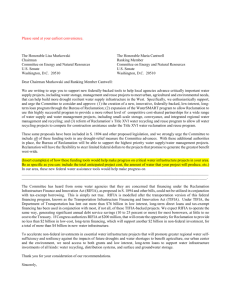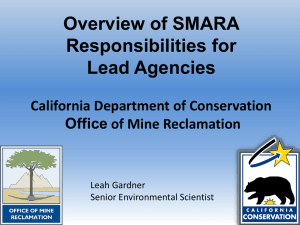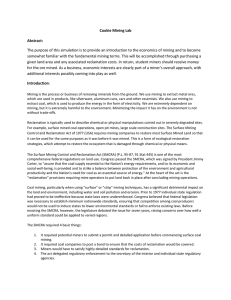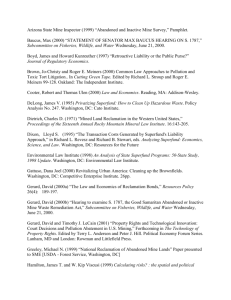161KB/PPT - CLU-IN
advertisement
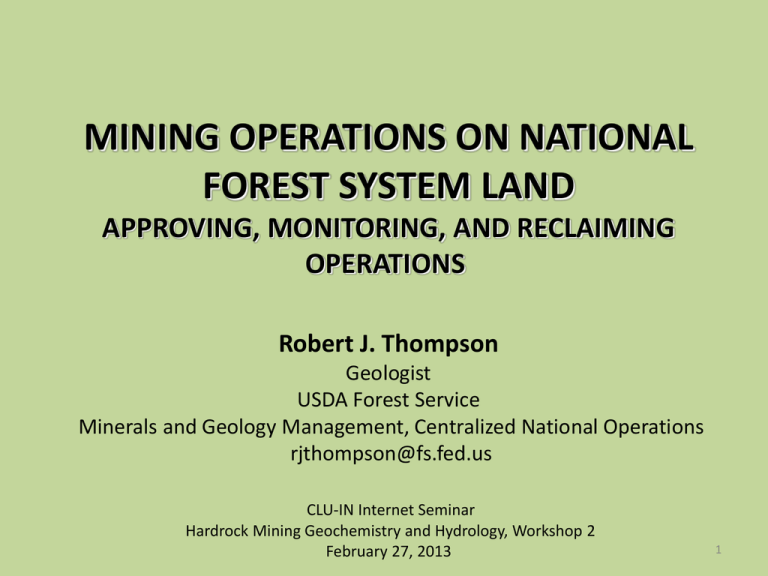
MINING OPERATIONS ON NATIONAL FOREST SYSTEM LAND APPROVING, MONITORING, AND RECLAIMING OPERATIONS Robert J. Thompson Geologist USDA Forest Service Minerals and Geology Management, Centralized National Operations rjthompson@fs.fed.us CLU-IN Internet Seminar Hardrock Mining Geochemistry and Hydrology, Workshop 2 February 27, 2013 1 MINING ON NATIONAL FOREST SYSTEM (NFS) LAND • • • • • • • LEGAL AUTHORITY APPROVAL PROCESS OTHER AGENCY INVOLVEMENT MITIGATION MONITORING ADAPTIVE MANAGEMENT RECLAMATION 2 LEGAL AUTHORITY • 1872 Mining Law, as amended • 1897 Organic Act • 1955 Multiple Use Mining Act • 36 CFR 228, Subpart A 3 APPROVAL PROCESS • Operator submits proposed Plan of Operation (Plan) to the FS detailing the operating proposal. • FS conducts NEPA analysis to determine issues, alternatives, and effects. • FS issues appealable decision that includes mitigation, monitoring, and reclamation requirements. • A reclamation bond is posted before operating. 4 OTHER AGENCIES AND PERMITS • Mining operations on NFS land must comply with laws and regulations administered by many other agencies—Federal, State, and Local. • The Forest Service is nearly always the lead or colead agency on NEPA analyses affecting NFS lands. Typically there will be one or more State or Federal Cooperating Agency participating in the NEPA process, and using the NEPA analysis as a basis for their decisions on permit issuance. 5 MITIGATION • Design standards and mitigation measures are used to: – avoid impacts altogether, where possible – minimize impacts by limiting the degree or magnitude of the action – rectify impacts by repairing, rehabilitating, or restoring the affected environment – reduce or eliminate the impact over time through maintenance operations – or to compensate for the impact by replacing or providing substitute resources or environments. 6 MONITORING • Monitoring is essential to ensure the desired results for mining operation. The scope and scale of this monitoring will obviously depend on the size of the operation and the potential resources affected. FS decisions on large mining operations typically contain a very detailed monitoring plan and cover such items as: • the item to be monitored (e.g. water quality) • • • • • • responsible party to do the monitoring location of monitoring sites method of measurement QA/QC frequency reporting requirements. 7 ADAPTIVE MANAGEMENT • Adaptive Management is the process where agencies use monitoring to determine if and when it is necessary to require adjustments to operating procedures, mitigation measures, and monitoring requirements; and to determine whether additional investigations and corrective actions are needed. 8 RECLAMATION • Approved Plans of Operation should include both interim and final reclamation requirements. Interim reclamation refers to short term seasonal or longer term market-based operating shutdowns. Final reclamation are those actions taken when the mining operation has been completed. • Forest Service reclamation requirements include reclaiming surface disturbance and preventing or controlling onsite and off-site damage to the environment. This includes control of erosion and landslides; control of water runoff; isolation, removal or control of toxic materials; reshaping and revegetation of disturbed areas where reasonably practicable; and rehabilitation of fisheries and wildlife habitat. • Reclamation of approved mining operations is financially assured through collection of a reclamation bond. The Forest Service typically bonds in conjunction with the States in order to avoid duplication. 9



